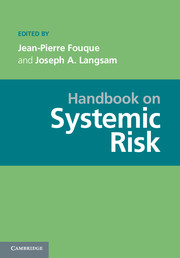Book contents
- Frontmatter
- Contents
- Contributors
- Introduction
- PART I DATA: THE PREREQUISITE FOR MANAGING SYSTEMIC RISK
- PART II STATISTICS AND SYSTEMIC RISK
- PART III MEASURING AND REGULATING SYSTEMIC RISK
- PART IV NETWORKS
- PART V SYSTEMIC RISK ANDMATHEMATICAL FINANCE
- PART VI COUNTERPARTY RISK AND SYSTEMIC RISK
- PART VII ALGORITHMIC TRADING
- PART VIII BEHAVIORAL FINANCE: THE PSYCHOLOGICAL DIMENSION OF SYSTEMIC RISK
- PART IX REGULATION
- 26 The New Financial Stability Framework in Europe
- 27 Sector-Level Financial Networks and Macroprudential Risk Analysis in the Euro Area
- 28 Systemic Risk EarlyWarning System: A Micro-Macro Prudential Synthesis
- PART X COMPUTATIONAL ISSUES AND REQUIREMENTS
- PART XI ACCOUNTING ISSUES
- References
27 - Sector-Level Financial Networks and Macroprudential Risk Analysis in the Euro Area
from PART IX - REGULATION
Published online by Cambridge University Press: 05 June 2013
- Frontmatter
- Contents
- Contributors
- Introduction
- PART I DATA: THE PREREQUISITE FOR MANAGING SYSTEMIC RISK
- PART II STATISTICS AND SYSTEMIC RISK
- PART III MEASURING AND REGULATING SYSTEMIC RISK
- PART IV NETWORKS
- PART V SYSTEMIC RISK ANDMATHEMATICAL FINANCE
- PART VI COUNTERPARTY RISK AND SYSTEMIC RISK
- PART VII ALGORITHMIC TRADING
- PART VIII BEHAVIORAL FINANCE: THE PSYCHOLOGICAL DIMENSION OF SYSTEMIC RISK
- PART IX REGULATION
- 26 The New Financial Stability Framework in Europe
- 27 Sector-Level Financial Networks and Macroprudential Risk Analysis in the Euro Area
- 28 Systemic Risk EarlyWarning System: A Micro-Macro Prudential Synthesis
- PART X COMPUTATIONAL ISSUES AND REQUIREMENTS
- PART XI ACCOUNTING ISSUES
- References
Summary
Abstract Recent interest in macroprudential analysis has highlighted the need for models that can identify counterparty risk exposures and shock transmission channels at the systemic level. We use data from the euro area financial accounts (flow of funds) to construct a sector-level network of bilateral balance sheet exposures. We then use the contingent claims approach to extend this accounting-based network of interlinked exposures to risk-based balance sheets which are sensitive to changes in leverage and asset volatility. We conclude that the bilateral cross-sector exposures in the euro area financial system constitute important channels through which local risk exposures and balance sheet dislocations can be transmitted, with the financial intermediaries playing a key role in the processes.
Keywords Financial networks, contingent claims analysis, macro-prudential analysis, financial accounts. JEL Classification: C22, E01, E21, E44, F36, G01, G12, G14
Introduction
Macroprudential analysis typically involves identification of risks, vulnerabilities and potential triggering events which, if crystallized, could flip the state of the financial system from stability to instability. But the events of the recent global financial turmoil have demonstrated that macroprudential analysis should, perhaps first and foremost, also aim at identifying links between sectors and channels through which local shocks may propagate wider in the financial system. Seeing the financial part of the economy as a network of interlinked exposures can help to detect such transmission mechanisms. Analysis of this financial network may then reveal that parts of the system that might not be considered particularly vulnerable to a given adverse scenario could still be affected due to their close interconnection with sectors that are directly confronted by the unforeseen events.
- Type
- Chapter
- Information
- Handbook on Systemic Risk , pp. 775 - 790Publisher: Cambridge University PressPrint publication year: 2013
References
- 3
- Cited by



